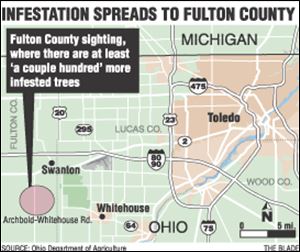
Ash borer hits Fulton County
5/29/2004
Add Fulton County to the emerald ash borer's growing list of devastated sites in Michigan and Ohio.
The Ohio Department of Agriculture yesterday said it has discovered the Asian beetle killing or threatening hundreds of ash trees in Swancreek Township in Fulton County on mostly private land in the vicinity of township roads 2, 4, EF, and C.
That area, which includes portions of the Maumee State Forest in Fulton County, is less than two miles west of the pair of sightings made last week in the Oak Openings Preserve Metropark in western Lucas County.
It also is about the same distance from this week's sighting at a portion of the Maumee State Forest that sits in western Lucas County.
Lucia Hunt, the Ohio Department of Agriculture's emerald ash borer survey coordinator, said there's "a couple of hundred there" when asked about the number of dying ash trees in the Fulton County infestation area. She said there could be hundreds more, because that area - like the floodplain of the Oak Openings metropark - has the kind of moist soil favored by ash trees.
Officials concede the sad re-
ality is that nobody really knows how bad the problem is yet, despite two weeks of intense focus on western Lucas and eastern Fulton counties following the discoveries inside the metropark and the state forest. Other nearby sightings were made earlier, including one in 2003 that affected numerous private parcels north of Whitehouse and one in March of this year on the south side of Toledo Express Airport and land adjacent to it.
Surveying throughout that region continues Tuesday. Looking for the perimeter of the infestation - not cutting down trees - is now top priority, officials said.
About 30,000 trees have been cut in Ohio because of the beetle this year, including 15,000 on the north side of Columbus.
Also yesterday, it was announced that there could be financial help for Michigan, Ohio and two other states who will share $28.2 million in federal funds to fight the emerald ash borer, the U.S. Department of Agriculture said.
Michigan will receive $16.5 million, U.S. Rep. Nick Smith, (R., Addison) said in a statement released Friday night. The rest of the $28.2 million will be shared by Ohio, Maryland and Virginia, where the infestation has not been as widespread.
Ohio officials said they are now focusing on defining the infestation boundaries, in an effort to somehow get ahead of the pest for next year so they are rethinking both their short and long-term strategies to fight the destructive pest:
w●Beginning the second week of June or thereafter, Ohio officials will strip some bark from injured trees to make them "trap trees." Doing so lures beetles to those trees with the natural release of chemical pheromones into the air. They are trapped by flypaper-like glue that will be applied to the trees.
Ohio is modeling its effort after one the Michigan Department of Agriculture is developing this summer for its 13-county quarantine area. The Michigan State University cooperative extension office in Monroe yesterday released a picture of placards that will be used to identify trees being used to trap the beetles. It encouraged people to keep their distance if they see the signs, although it said the glue applied to trees is nontoxic.
The idea is to learn more about the beetle by capturing it and studying it. Trap trees, by themselves, aren't expected to kill all the beetles, officials said.
w●In late June or early July, officials from Michigan, Ohio, and Indiana will have a meeting in the Toledo area to discuss the potential of moving forward with planning for an enormous clear-cut of ash across those states.
A huge, firebreak-like swath up to six miles wide would be cut across the states in a semicircular pattern, similar to a massive clear-cut Ontario did this year across its southwestern peninsula. Some 84,000 Ontario ash trees were felled from the Lake St. Clair to Lake Erie shoreline in hopes of keeping the emerald ash borer from moving eastward into the province.
The unprecedented operation for Michigan, Ohio, and Indiana would cost millions of dollars and likely result in the loss of hundreds of thousands of ash trees. But officials have said it may be the only way they can head off the pest, even if it takes them years to accomplish.
Contact Tom Henry at:
thenry@theblade.com
or 419-724-6079.